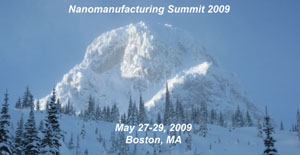
This improved understanding will become a central research topic for discoveries and innovations toward new commercial applications, as well as new paradigms in the manufacturing sciences that address the necessary economy of scale requirements for these new products. Integrated systems nanomanufacturing must combine the knowledge that has evolved to achieve this controlled manipulation of materials and structures with emerging capabilities and methodologies to realize next generation systems.
Integrated systems nanomanufacturing research challenges include:
- Establishing reliable, reproducible, and economically viable means of assembling arrays of nanoscale components and integrating the nanostructures within device architectures that span multiple length scales. This must be accomplished for application appropriate manufacturing platforms ranging from wafer-based batch processing to high speed, low cost roll-to-roll manufacturing.
- The investigation of new nanotechnology system architectures for various applications, including nanoelectronics, hybrid nanobiosystems, energy conversion and storage systems, water filtration, information technologies, textiles, intelligent materials, and sensors and structures for use in medicine, agriculture, and basic biological research.
- Understanding, exploiting, and extending the knowledge of system behavior at the nanoscale, specifically the behavior of integrated systems with a large number of nanocomponents, self-assembly and evolutionary methodologies in nanosystems, and the impact of individual nanocomponents on the collective behavior of an integrated system.
- The development of tools for measuring, simulating, and restructuring matter with nanometer scale precision and the implementaion of these tools in scaled manufacturing environments for in situ or embedded process control.
- Information exchange relative to systems nanomanufacturing, including standardized terminologies, federated materials and process databases, intelligent informatics tools, and best practices for scalable systems integration.
By addressing these issues, integrated systems nanomanufacturing will provide unprecedented control and understanding of the collective functionality that networks of interdependent nanocomponents may enable. Integration of micro, nano, and molecular scale designs will bring nanoscience and engineering to new levels wherein nanoscale building blocks make up a wholly integrated system designed to perform specific tasks or provide specific properties enabling a range of new applications and products.
